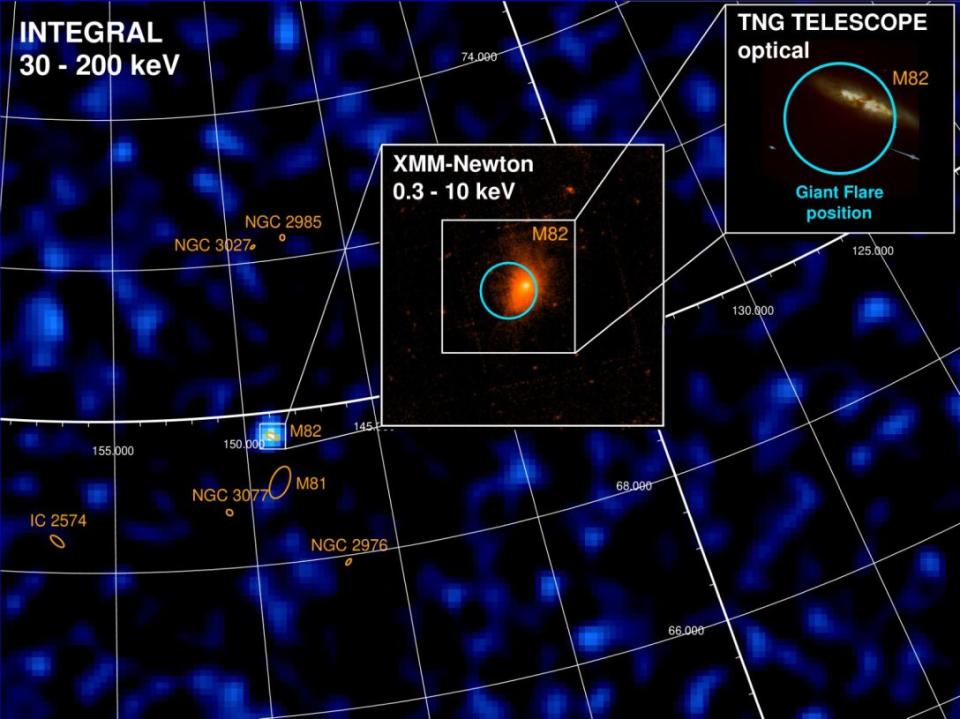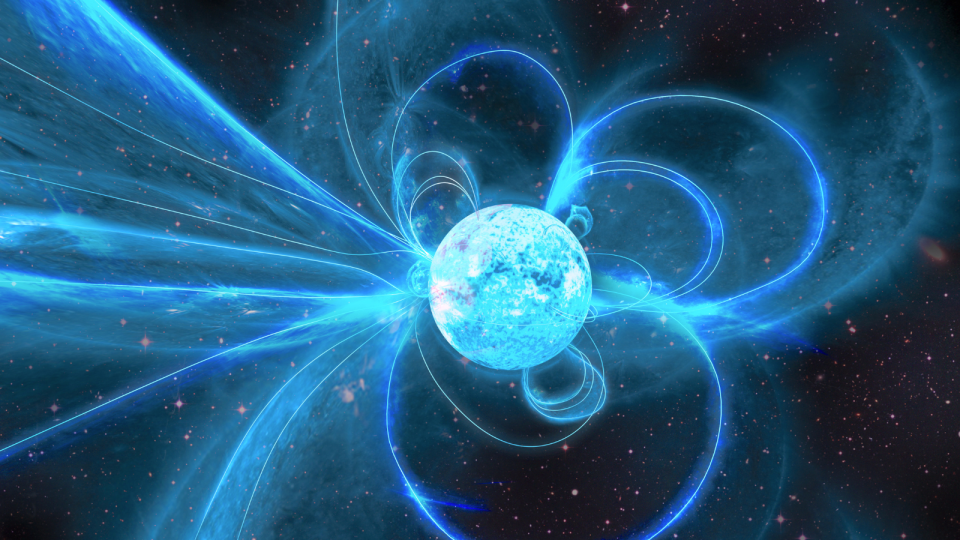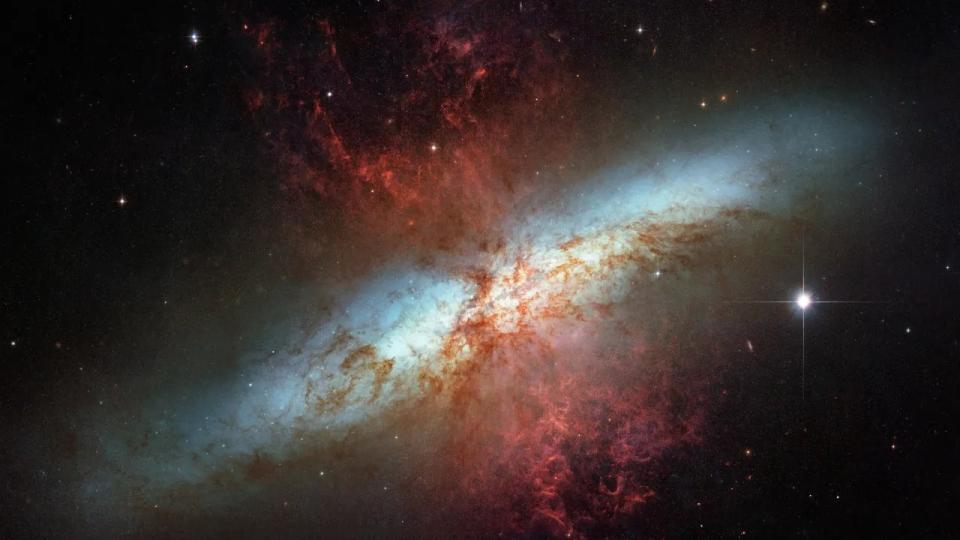Astronomers think they have found a rare, massive burst erupting from an extremely magnetic dead star, or magnetar, that was bright enough to illuminate an entire galaxy. If true, the discovery would mark the first time gamma rays have been observed from a “recently deceased” neutron star erupting outside the Milky Way.
The eruption was first spotted by the Integral Science Data Center in Geneva as a brief burst of high-energy gamma rays that lasted just a tenth of a second. Integral sent an alert to astronomers who realized just 13 seconds after the outburst that these gamma rays appeared to come from the bright galaxy Messier 82 (M82), nicknamed the “Cigar Galaxy” because of its elongated shape; the Cigar Galaxy is located about 12 million light-years from Earth.
However, all this left astronomers with a mystery to solve. Was this a fairly common gamma-ray burst they saw from this galaxy, which is also home to intense star formation, or did this definitely represent the rare flare-up of a highly magnetic magnetar?
Related: One of the universe’s most ‘extreme’ dead stars has just unexpectedly come back to life
“We immediately realized that this was a special warning,” Sandro Mereghetti, research leader and scientist at the National Institute for Astrophysics (INAF-IASF), said in a statement. “Gamma-ray bursts come from far away and all over the sky, but this burst came from a bright nearby galaxy.”
To investigate the gamma-ray burst, Mereghetti and colleagues made quick follow-up observations of the blast’s source with the XMM-Newton space telescope. They reasoned that if this explosion of gamma rays was a brief gamma-ray burst, created as a result of a powerful event such as two neutron stars colliding and merging, there should also be an associated afterglow, seen in X-rays and visible light. . This event would also have ‘ringed’ spacetime with ripples called ‘gravitational waves’.
“The XMM-Newton observations showed only the hot gas and stars in the Milky Way,” said team member and INAF researcher Michela Rigoselli. “If this explosion had been a brief gamma-ray burst, we would have seen a fading source of X-rays from the site, but this afterglow was not present.”
Integral’s role in enabling researchers to get off the target quickly in investigating this gamma-ray burst was – apologies in advance – integral to determine its true origin and trace it back to a magnetar eruption in M82.
“When unexpected observations like these are picked up, Integral and XMM-Newton can be flexible in their schedules, which is essential in time-critical discoveries,” Integral project scientist Jan-Uwe Ness explained in the statement. “In this case, if the observations had been made even a day later, we wouldn’t have such strong evidence that this was indeed a magnetar and not a gamma-ray burst.”

A deceased and flaring magnetar
Magnetars are a type of neutron star notable for their incredibly powerful magnetic fields. Like all neutron stars, magnetars are born when a star with at least eight times the mass of the Sun depletes the fuel they need for nuclear fusion in their cores. This ends the external force associated with radiation pressure that has protected these stars from collapsing under their own gravity for millions, or sometimes billions, of years.
With this protection ended, the core of this dying star collapses while the outer layers, which represent most of the star’s mass, are blown away in a supernova explosion. The result is a dead stellar core with a mass between one and twice that of the Sun, crammed into a width of no more than 20 kilometers.


This rapid collapse results in neutron stars being composed of the densest known matter in the universe, just a tablespoon of which would weigh 1 billion tons if brought to Earth. There are two other extreme consequences of this collapse.
Just as an ice skater on Earth takes advantage of the conservation of angular momentum by retracting his arms to increase the speed of his rotation, the rapid radial reduction of a dying star’s nucleus causes a newborn neutron star to spin at incredible speeds. It has been discovered that some young neutron stars spin as much as 700 times per second.
In addition, the collapse causes the field lines of the star’s magnetic field to become closer together. The closer the field lines are to each other, the more powerful a magnetic field is. That means some neutron stars have the most powerful magnetic fields in the entire cosmos. Both the rotation rate and intense magnetism of neutron stars decrease as these stellar remnants age.
“Some young neutron stars have extra strong magnetic fields, more than 10,000 times greater than those of typical neutron stars. These are called magnetars. They emit energy in bursts, and occasionally these bursts are gigantic,” researcher Ashley Chrimes of the European Space Agency. said.


Magnetar bursts are thought to be caused by “starquakes” on the surfaces of these highly magnetic young neutron stars disrupting their intense magnetic fields. They are both gigantic and vanishingly rare.
In fifty years of observing the cosmos in gamma rays, humanity had previously noticed only three outbursts. These were found in 1979, 1998 and 2004 and all came from magnetars in the Milky Way.
But perhaps it is fortunate that flaring magnetars are rare. The December 2004 example, caused by a magnetar 30,000 light-years from Earth, was so powerful that it actually affected our planet’s upper atmosphere. The effect was similar to that caused by solar flares, but the sun is 1.9 billion times closer to Earth than the magnetar behind the 2004 gamma-ray flare. Let that sink in for a moment.
The Integral discovery marks the first time a magnetar burst outside the Milky Way has been observed. However, the team believes that some of the other short gamma-ray bursts seen by Integral were actually also bursts from extragalactic magnetars.
“However, eruptions of such a short duration can only be captured by chance if an observatory is already pointing in the right direction,” Jan-Uwe said. “This makes Integral, with its large field of view, more than 3,000 times larger than the moon-covered sky, so important for these detections.”
RELATED STORIES:
— A new approach could help scientists peer inside a neutron star
— ‘Glitches’ of dead stars can reveal the origin of fast radio bursts
— The most massive neutron star ever observed is shredding its companion
The position of the magnetar in M82 is important because this bright galaxy is home to a burst of intense star formation. This confirms that massive stars in such starburst regions “live fast and die young,” leaving young neutron stars as turbulent, rapidly spinning magnetars.
The team will now look for more magnetars in starburst galaxies to better understand the lives and deaths of massive stars in these regions, and to better understand how neutron stars evolve over time.
“This discovery opens our search for other extragalactic magnetars,” Chrimes said. “If we can find many more, we can begin to understand how often these outbursts occur and how these stars lose energy in the process.”
The team’s research was published Wednesday (April 24) in the journal Nature.